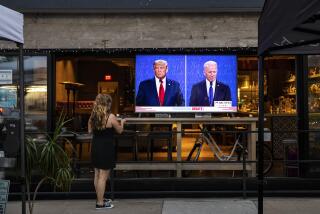Going a la carte would destroy pay-TV industry, analyst says
As more options for TV viewing emerge, and watching programming on smartphones and tablets becomes more popular, there’s more pressure on cable and satellite companies to let consumers choose what channels they want to pay for.
Some see such an “a la carte” system as the future of the pay-TV industry, arguing that it would be more fair for consumers.
But according to Laura Martin, an analyst at Needham & Co., such a move would be a disaster for the business.
PHOTOS: Cable versus broadcast ratings
If the pay-TV industry undid the practice, known as bundling, it would lose about $70 billion, or half its revenue, annually, she said. In an ominous prediction, Martin concluded that unbundling could halve the total market capitalization of the TV ecosystem.
“Our calculations suggest that if the TV bundle starts to degrade, $400 million of market capitalization will turn into $200 million over 10 years, based on the datapoints from music and newspapers,” Martin wrote in a note to clients Monday.
Fewer than 20 channels would survive in such a universe, and virtually every household watches several channels that would not make the cut, she said.
PHOTOS: Hollywood Backlot moments
HBO, Showtime and Starz would live on in an a la carte world, because they already rely completely on subscription revenue, she said.
That assumes a world in which content costs would be backed by revenue from consumer subscriptions, rather than advertising, which now supports half of those costs, according to Martin.
Pay-TV companies reported a total of about $142 billion in revenue in 2013, split half-and-half between advertising and subscription fees.
PHOTOS: Celebrities by The Times
Bundles are useful to the pay-TV industry because they help companies make money off shows that aren’t hits, even in a hit-based business. In addition, bundles are attractive to consumers because they offer channels that interest different members of the household for different reasons, thus letting them maintain their pricing power.
“I may feel that Bravo, A&E, History Channel and Food Network justify the $70 a month fee, while my husband attributes more value to the sports channels,” Martin said. “In each case, the price/value relationship is intact, but predicated on different channels for each person in the household.”
To see the risks of unbundling, one might point to the music and newspaper industries. Now that the old system of bundling songs into albums has unraveled, global music sales are down by more than half from 1999, Martin said. Unbundling articles from newspapers by making them available online has caused a similar shrinkage.
But what if the industry just unbundled sports channels?
Those who aren’t sports fans have long protested the fact that they pay a lot of money for a category of content they have no interest in, as the costs of that programming continue to rise.
Half of all subscriber fees are related to sports channels, but sports account for only about a quarter of viewing, Martin said. This certainly drives consumer complaints.
But creating a separate tier for sports would lower pay-TV revenue by $13 billion, Martin calculated.
“The best solution to this hard problem is to find a negotiated compromise that allows both content and distribution to win and the bundle to stay intact, or grow,” she said. “We can find no math where unbundling is the best economic answer.”
ALSO:
Hulu sale is canceled; owners double down on the video site
‘Despicable Me 2’ beats ‘Grown Ups 2’; ‘Pacific Rim’ disappoints
DreamWorks Animation grooming Lassie for a return to the spotlight
Twitter/@rfaughnder
More to Read
From the Oscars to the Emmys.
Get the Envelope newsletter for exclusive awards season coverage, behind-the-scenes stories from the Envelope podcast and columnist Glenn Whipp’s must-read analysis.
You may occasionally receive promotional content from the Los Angeles Times.







